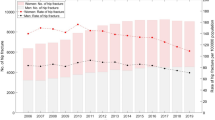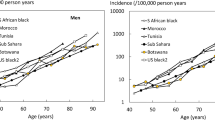Abstract
We assessed the incidence of hip fracture and ecological correlates in residents of 14 communities in six countries of Southern Europe. Hip fracture cases were recorded prospectively in defined catchment areas over a 1-year interval. A retrospective questionnaire was used to assess ecological differences between communities. During a 1-year period of observation a total of 3629 men and women over the age of 50 years were identified with hip fracture from a catchment of 3 million. In all communities the fracture rate increased exponentially with age. There were large and significant differences between centres in the doubling time for hip fracture risk with age and in crude and age-standardized rates. Greater than 4-fold and 13-fold differences in age-standardized risk were found amongst men and women respectively. The lowest rates were observed from Turkey and the highest from Seville, Crete and Porto. Fractures were significantly more frequent among women than men with the exception of three rural Turkish centres. Indeed, in rural Turkey the normal female/male ratio was reserved. Variations in incidence between regions were greater than the differences within centres between sexes, and there was a close and significant correlation between incidence rates for men and those for women in the regions studied. Excess female morbidity increased progressively from the age of 50 years but attained a plateau after the age of 80 years, suggesting a finite duration of the effect of the menopause. The retrospective questionnaire completed by 80% of cases suggested that differences in incidence between the communities studied could not be explained by differences in gonadal status in women. In both men and women cross-cultural associations were found with factors related to age or socioeconomic prosperity, the majority of which disappeared after adjustment for age. We conclude that there are marked and sizeable differences in the incidence rates of hip fracture throughout Southern Europe. The reasons for these differences are not known but affect both men and women, and are likely to be related to lifestyle or genetic factors rather than to differences in endocrine status.
Similar content being viewed by others
References
Cummings SR, Kelsey JL, Nevitt MC, O'Dowd DJ. Epidemiology of osteoporosis and osteoporotic fractures. Epidemiol Rev 1985;7:178–208.
Obrant KJ, Bengner U, Johnell O, Nilsson BE, Sernbo I. Increasing age-adusted risk of fragility fractures: a sign of increasing osteoporosis in successive generations? Calcif Tissue Int 1989;44:157–67.
Royal College of Physicians. Fractured neck of femur: prevention and management. London: Royal College of Physicians, 1989.
Maggi S, Kelsey JL, Litvak J, Heyse SP. Incidence of hip fractures in the elderly: a cross-national analysis. Osteoporosis Int 1991;1:232–41.
Melton LJ, O'Fallon WM, Riggs BL. Secular trends in the incidence of hip fractures. Calcif Tissue Int 1987;41:57–64.
Sernbo I, Johnell O, Andersson T. Differences in the incidence of hip fracture: comparison of an urban and a rural population in southern Sweden. Acta Orthop Scand 1988;59:382–5.
Jacobsen SJ, Goldberg J, Miles TP, Brody JA, Stiers W, Rimm AA. Regional variation in the incidence of hip fracture: US white women aged 65 years and older. JAMA 1990;264:500–2.
Johnell O, Gullberg B, Allander E, Kanis JA. The apparent incidence of hip fracture in Europe: a study of national register sources. Osteoporosis Int 1992;2:298–302.
Chalmers J, Ho KC. Geographical variations in senile osteoporosis: The association with physical activity. J Bone Joint Surg [Br] 1970;52:667–75.
Lau ECM, Cooper C, Wickham C, Donnan S, Barker DJP. Hip fracture in Hong Kong and Britain. Int J Epidemiol 1990;19:1119–21.
Kawashima T. Epidemiology of the femoral neck fracture in 1985, Niigata Prefecture, Japan. J Bone Miner Metab 1989;7:118–26.
Kanis JA. Report of the joint WHO/EOPF/NIAMS(NIH) consultation on osteoporosis. Basel: European Foundation for Osteoporosis and Bone Disease, 1990.
Ferrandez L, Hernandez J, Gonzales-Orus A, Devesa F, Ceinos M. Hip fracture in the elderly in Spain. Acta Orthop Scand 1992;63:386–8.
Diez A, Puig J, Martinez MT, Diez JL, Aubia J, Vivancos J. Epidemiology of fractures of the proximal femur associated with osteoporosis in Barcelona, Spain. Calcif Tissue Int 1980;44:382–6.
Dequeker J, Ranstram J, Valsson J, Sigurgevisson B, Allender E, MEDOS Study Group. The Mediterranean Ostoporosis (MEDOS) Study questionnaire. Clin Rheumatol 1991;10:54–72.
Elffors L, Gullberg B, Allander E, Johnell O, Kanis JA. Methodology of MEDOS multicentre study of hip fracture incidence: validity and relevance considerations. Bone 1993;14:545–50.
Abelow BJ, Holford TR, Insogna KL. Cross-cultural association between dietary animal protein and hip fracture: a hypothesis. Calcif Tissue Int 1992;50:14–8.
Matkovic V, Kostial K, Simonovic I, Buzina R, Brodarec A, Nordin BEC. Bone status and fracture rates in two regions of Yugoslavia. Am J Clin Nutr 1979;32:540–9.
Finsen V, Benum P. Changing incidence of hip fractures in rural and urban areas of central Norway. Clin Orthop 1987;218:104–11.
Ray WA, Griffin MR, West R, et al. Incidence of hip fracture in Saskatchewan, Canada 1976–1985. Am J Epidemiol 1990;131:502–9.
Naessen T, Persson I, Adami HO, Bergstrom R, Bergkvist L. Hormone replacement therapy and the risk for first hip fracture: a prospective, population-based cohort study. Ann Intern Med 1990;113:95–103.
Hutchinson TA, Polansky SM, Feinstein AR. Postmenopausal oestrogens protect against fractures of hip and distal radius: a case control study. Lancet 1979;2:705–9.
Weiss NS, Ure CL, Ballard JH, Williams AR, Daling JR. Decreased risk of fractures of the hip and lower forearm with postmenopausal use of estrogen. N Engl J Med 1980;303:1195–8.
Kreiger N, Kelsey JL, Holford TR, O'Connor T. An epidemiolo-gic study of hip fracture in post-menopausal women. Am J Epidemiol 1982;116:142–8.
Smith RW. Dietary and hormonal factors in bone loss. Fed Proc 1967;26:1737–46.
Kanis JA. Calcium requirements for optimal skeletal health. Calcif Tissue Int 1991;49(Suppl):33–41.
Chapuy MC, Arlot ME, Duboef F, Brun J, Crouzet B, Arnaud S, et al. Vitamin D3 and calcium to prevent hip fractures in elderly women. N Engl J Med 1992;327:1637–42.
Kanis JA, Johnell O, Gullberg B, Allander A, Dilzen G, Gennari C, et al. Evidence for the efficiency of bone active drugs in the prevention of hip fracture. BMJ 1992;305:1124–8.
Kanis JA, Passmore R. Calcium supplementation of the diet. BMJ 1989;298:137–40, 205-8, 673-4, 1523.
Lau E, Donnan S, Barker DJP, Cooper C. Physical activity and calcium intake in fracture of the proximal femur in Hong Kong. BMJ 1988;297:144–3.
Wickham CAC, Walsh K, Cooper C, Barker DJP, Margetts BM, Morris J, Bruce SA. Dietary calcium, physical activity and risk of hip fracture: a prospective study. BMJ 1989;299:889–892.
Cooper C, Barker DJP, Wickham C. Physical activity, muscle strength and calcium intake in fracture of the proximal femur in Britain. BMJ 1988;297:1443–6.
Falch JA, Ilebekk A, Slungaard U. Epidemiology of hip fractures in Norway. Acta Orthop Scand 1985;56:12–6.
Finsen V. Improvements in general health among the elderly: a factor in the rising incidence of hip fractures? J Epidemiol Commun Health 1988;42:200–3.
Nagant de Deuxchaisnes C, Devogelaer JP. Increase in the incidence of hip fractures and of the ratio of trochanteric to cervical hip fracture in Belgium. Calcif Tissue Int 1988;42:201–3.
Boyce WJ, Vessey MP. Rising incidence of fractures of the proximal femur. Lancet 1985;1:150–1.
Wallace WA. The increasing incidence of fractures of the proximal femur: an orthopaedic epidemic. Lancet 1983;1:1413–4.
Lewis AF. Fracture of the neck of femur: changing incidence. BMJ 1981;283:1217–20.
Johnell O, Nilsson B, Obrant K, Sernbo I. Age and sex patterns of hip fracture: changes in 30 years. Acta Orthop Scand 1984;55:290–2.
Bengner U, Johnell O, Redlung-Johnell I. Changes in incidence and prevalence of vertebral fractures during 30 years. Calcif Tissue Int 1988;42:293–6.
Bengner U, Johnell O. Increasing incidence of forearm fractures: a comparison of epidemiologic patterns 25 years apart. Acta Orthop Scand 1985;56:158–60.
Kanis JA, Pitt FA. Epidemiology of osteoporosis. Bone 1992;13:(Suppl):S7-S15.
Law MR, Wald NJ, Meade TW. Strategies for prevention of osteoporosis and hip fracture. BMJ 1991;303:453–9.
Stevenson JC, Kanis JA, Christiansen C. Bone density measurement. Lancet 1992;339:370–1.
Stott S, Stevenson W. The incidence of femoral neck fracture in New Zealand. NZ Med J 1980;6–9.
Solomon L. Osteoporosis and fracture of the femoral neck in the South African Bantu. J Bone Joint Surg [Br] 1968;50:2–13.
Wong PCN. Fracture epidemiology in a mixed South-east Asian Community (Singapore) Clin Orthop 1966;45:55.
Author information
Authors and Affiliations
Rights and permissions
About this article
Cite this article
Elffors, I., Allander, E., Kanis, J.A. et al. The variable incidence of hip fracture in Southern Europe: The MEDOS study. Osteoporosis Int 4, 253–263 (1994). https://doi.org/10.1007/BF01623349
Received:
Accepted:
Issue Date:
DOI: https://doi.org/10.1007/BF01623349




